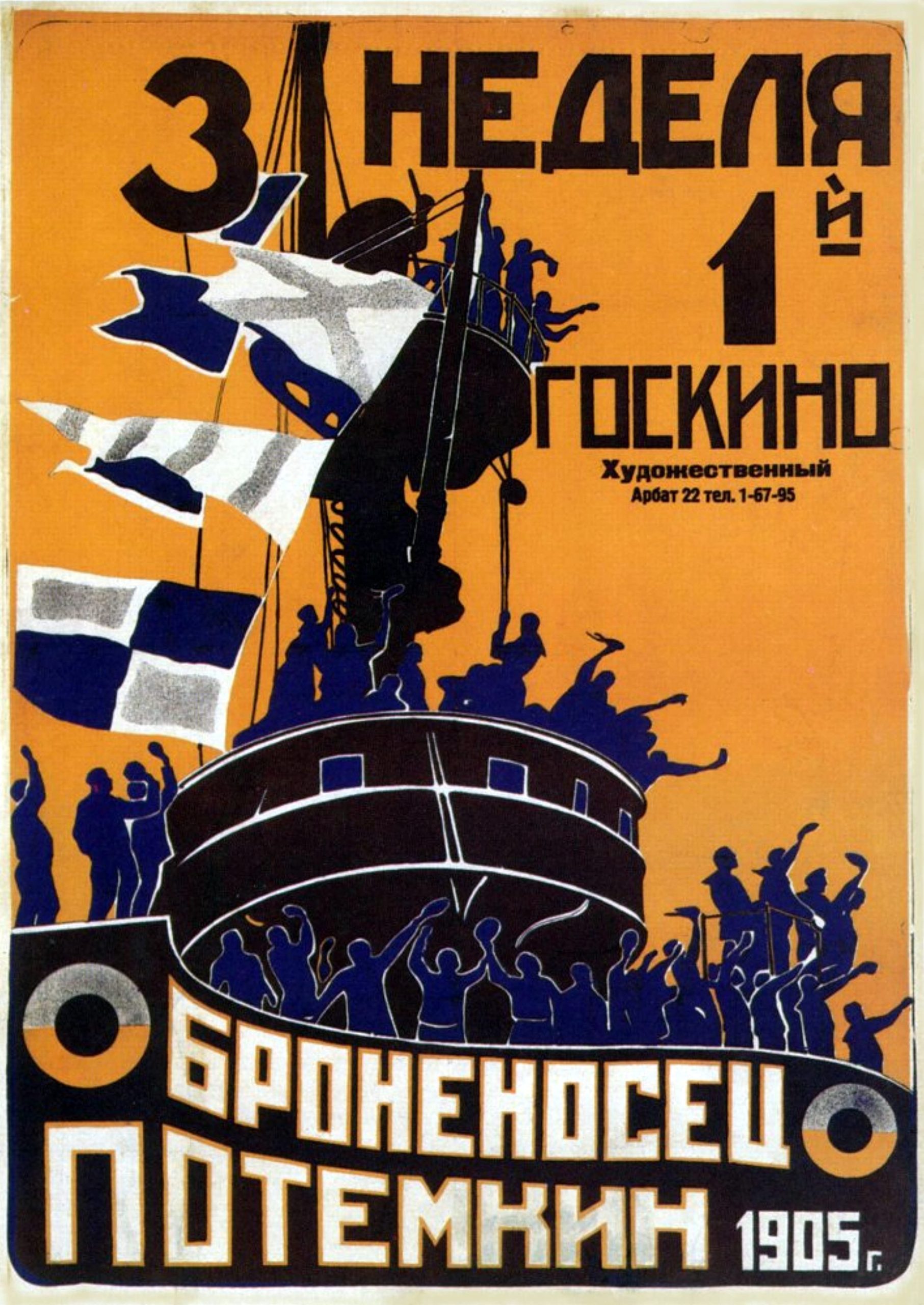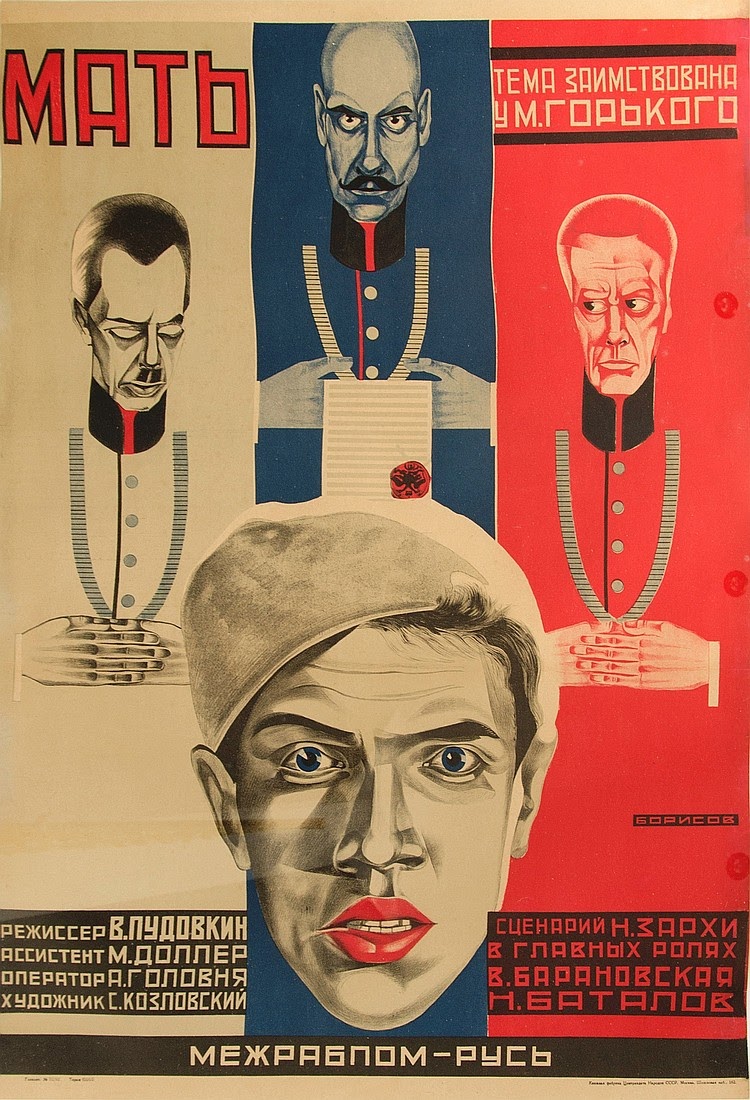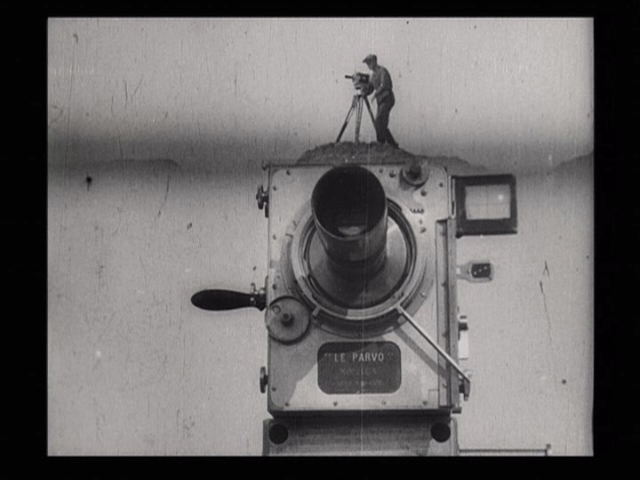8 Soviet Film
Learning Objectives
- Understand the philosophies that produced Russian film
- Learn about the editing techniques used by Lev Kuleshov, Sergei Eisenstein, Dziga Vertov, and Vsevolod Pudovkin.
- Learn about the theories of directors from this era of Russian film
Russian cinema in the early days of the revolution was an important format of new cinema in Europe that had a great impact on The United States and the West. Russians utilized an expressive way of editing and new forms of film cutting to increase the impact of a film’s effect on audiences. The Russians had been allies with the West against the Germans in the First World War. However, during the war, discontent with the Russian government, they broke out. The Tsar was attacked and overthrown by the Bolshevik communist forces. Russians rejected the old style of the world they knew, dropped out of the war, and isolated themselves from the West. The French, the British, and the Americans blamed the Russians for leaving their coalition and despite the fact that they were having an internal revolution. The United States, the British, and the French were cut off trade from Russia as a punishment.
For the Russian people, there were very few film factories, so making movies was more difficult. The film schools in Russia had to determine a way to educate students about film without the same supplies of new film. They arrived at a strategy that focused on editing over new technology in the creation of films. Thus, instructors in Russian film schools used pre-existing films from many cultures to teach students about film production and editing. The process worked by instructors giving students existing films and having them recut the scenes into a different structure. This allowed them to reedit the film to create a different meaning.
Soviet Film: Philosophies
This technique was consistent with Marxist philosophy. Marxist thinkers believed the West and capitalism robbed the people, making them addicted to a false consciousness. Thus, they believed that socialism freed people from ideologies of greed, and philosophies where rich autocrats are at the pinnacle of society, while others stayed trapped in poverty. To Marxists, the keys to success in capitalism was elusive to the common people and favored the wealthy. Communism or socialism freed populations from false beliefs of capitalist greed and delusions that the poor could pull themselves out of poverty. So Marxist film theory argued that American films sold the public a delusion of wealth and happiness. They believed that Marxist filmmaking told audiences more truthful stories of collectivism and hard work, to make all people more responsible and productive. Russian Bolshevik communists believed that the West and its messages of propaganda and capitalism were destructive to the common people. The Russians wanted to revise and redraw the messages the West had been sending to people about greed, commerce, and growth in the capitalistic system. Therefore, philosophically as well as practically, it made perfect sense to the Russians to re-write films to re-edit films to give them a different message.
Key Takeaways
- Due to the lack of film factories and resources in post-revolutionary Russia, film schools taught editing skills rather than focusing production.
- The Russian approach to filmmaking aligned with Marxist philosophy, which critiqued capitalism’s promises of wealth and happiness.
- Russian filmmakers sought to create films that told more truthful stories that highlighted their values of collective work and socialism.
Soviet Film: Editing Techniques
The Russians were very theoretical about the creation of films, and they came up with a lot of theories and ideas about film. One of the first Russian film makers and professors to create new theories was Lev Kuleshov. Kuleshov performed an experiment that later became known as the Kuleshov experiment. Kuleshov would show two scenes juxtaposed together side-by-side, and then he would show another scene to try to determine what people would think of the first two scenes. This technique was related to the Hegelian dialectic, a German idea from the 19th century that stated that human thinking progressed by steps. According to Hegel, when we initially have an idea, this becomes the thesis or the main idea. This idea is often supplanted by a new idea which we call the antithesis or the new idea. Then often times we realize that the first idea and the second idea weren’t successful on their own, so we devise a third idea we call the synthetic/new idea Thus a thesis and anti-thesis creates a synthesis, a combination of the first two ideas. By dialectical processes, we create new ideas and society moves forward. Russians adopted this thinking. They saw capitalism as modified feudalism, still benefiting wealth and power. The third system, communism, shared amongst everyone, benefited the poor more, and equalized the means of monetary distribution.
Through film editing Lev Kuleshov tried to make this idea a reality. He would show an image of something, for example a man’s face, and then he would juxtapose that image with a portrait of a mother and a baby, the third image returned to the man in the first image. The third image merely repeated the original image. Thesis, anti-thesis, and synthesis. The man’s face is a thesis. The mother and baby become the anti-thesis, and finally the man again creates synthesis. This forms an idea about what the man is thinking. After seeing the second clip, the man now to be smiling at the mother and child. Kuleshov argued that the audience identified the first image with the second and third image. The experiment showed the thesis/anti thesis combined by audiences to arrive at a synthetic third idea. Kuleshov was able to manipulate audiences psychologically with the images.
In the 1960’s, Hitchcock explained the Russian idea to a reporter in an interview. He showed an image of himself and then juxtaposed the Hitchcock image with a picture of a baby. The effect is that Hitchcock is a kindly old man looking at a baby. Hitchcock repeats the experiment this time substituting a beautiful girl in a bikini for a baby. The effect is that now Hitchcock is seen as a dirty old man leering at young girls. In reality, people are responding to the same image with a different intermediary image interposed between the first and third image, but changing the intermediary image conveys a drastically different message. The Kuleshov experiment was successful in showing audiences could have their consciousness changed by film.
The Kuleshov effect of manipulating audience attention or misleading the audience is common today. An assumption of reality is often laid out and is later undercut by the introduction of new information. In this style, what may be seen may mislead. The Butterfly Effect uses this idea to undermine our beliefs through the notion of chaos theory. In 2021, Joe Wright’s production for Netflix, The Woman in the Window with Amy Adams, uses a similar effect of juxtaposition. The audience assumes because both are presented in sequence both bits of information are true. Wright feeds the audience some information that seems trustworthy, which allows the audience to be manipulated.
Today, many of the films that utilize the Eisenstein style of film editing have little to do with politics, and more to do with psychologically manipulating audience emotions. For example, one of the famous examples of the Kuleshov effect occurs in The Sixth Sense. The kid can see ghosts, but through juxtapositions, we don’t know that some people in the film who appear as alive may be ghosts too. The use of montage or the Kuleshov effect creates the dynamic of hiding and revealing things to the audience.
Key Takeaways
- The Kuleshov effect is based on an experiment by Lev Kuleshov, in which a series of juxtaposed images in sequence are used to alter the meaning of each other.
- Alfred Hitchcock notably explained the Kuleshov effect during an interview in the 1960’s, demonstrating how it manipulates the audience’s perspective.
- The Kuleshov effect continues to be used commonly in film. Famous examples of the Kuleshov effect in action are The Sixth Sense, and more recently, The Woman in the Window, starring Amy Adams.

One of the big film makers of the early Soviet period was Sergei Eisenstein. He agreed that film could alter thought. Ideological film altered the way films were built and constructed. Eisenstein created a film called Battleship Potemkin (1925) to exploit the potential of this ideological film process. The film portrays an attack on the Russian people by the Tsar’s men during the Tsarist era. In the film, the people are attacked by the Russian Tsarist soldiers.
Hoping the sailors on board the ship will mutiny and protect them from the ground soldiers, the people run to the Battleship Potemkin which is harbored in the Odessa harbor. The people appeal to the Russian sailors on board the ship to help them fight against the soldiers on the ground. The sailors mutiny, overthrow their Tsarist commanders, and help the people by firing on the Tsarist soldiers. Eisenstein employed the Hegelian idea with shots of the soldiers separate, then he made shots of the people running separately so there was a thesis/antithesis idea established. The third shot returned to the soldiers displaying images of the soldiers oppressing the people. In essence the soldiers never hurt anyone, but the notion of harm is created by juxtaposition. Using these Russian philosophies, Eisenstein shaped the minds of the audience.

There were other directors that also introduced different theories of editing in Russia. One of the most important film makers was Pudovkin, who believed in a different form of editing. His editing style was more consistent with the ideas and narratives of the film. His form of editing was known as constructivist editing. Constructivism was an art theory that originated in Russia in the early years of the twentieth century. Like the French and the Germans, the Russians were deeply influenced by art movements. The constructivists believed that the world should reflect modern industrial society and urban spaces. Eisenstein’s form of editing was considered collision editing or a more violent form where two ideas compete for centrality. Two ideas are brought together creating a third, more complicated idea. Pudovkin’s style simply constructs two coherent ideas together like building blocks in architecture. It built on original ideas, furthering the story by continuing to introduce ideas that are consonant together. One of Pudovkin’s most important films was called Mother. In the film a mother has a son who is not a member of the Communist Party and doesn’t adhere to the Communist Party principles. She tries to find a way to save him. She determines the only way to save him is to turn him in to the Communist Party, so they can save him from a life of false beliefs. This film exemplifies the engravement of Soviet narratives within Russian film.

Man with a Movie Camera, 1929
Some directors, like Dziga Vertov, were afraid that collision editing and constructivism techniques would take away from the director’s vision and what meaning they wish to convey in their films. Vertov made a film called Man with a Movie Camera, which was a documentary film. Vertov did not trust editing to tell the story, for fear the editing might be re-interpreted or misinterpreted in a film. Therefore, he claimed his films only showed real life. While he could put scenes together in a film in a wild, strangely edited collision fashion, he claimed that everything in the film was real life and that he only recorded reality, despite how speedy and clever the editing of his scenes was. He used editing to increase or slow down the pace, to creating interest in the film. He argued that his editing was not used for a political purpose, and that the presence of politics was simply the subject matter. Man with a Movie Camera simply shows the day-to-day life of working-class communist people living in Moscow during the early days of the Russian Revolution.
Key Takeaways
- Sergei Eisenstein, a prominent director in Russian film, also used juxtaposed images, notably in his film, Battleship Potemkin.
- The film technique used by Pudovkin was called constructivism, which was based in weaving two main ideas together as the film progresses, rather than introducing conflicting information to cause mystery.
- Dziga Vertov used intricate editing techniques but disagreed that editing should be used as a way to convey meaning. He believed that this style of film making would take away from the director’s vision, and cause misinterpretation amongst audiences.
- Vertov preferred filming “real life,” only shooting what he called documentaries, despite his heavy use of editing techniques. This is seen through his movie, Man with a Movie Camera, which details the daily life of people in Soviet Russia.
Soviet Film: Soviet Realism
Soviet cinema had a brief flowering from 1920 to 1930, when many experiments occurred and were allowed. Eisenstein practiced collision editing, Pudovkin offered constructivist editing, and Vertov used a style of editing that offered wild speed-shots, though he disavowed editing as a tool to invoke the films meaning.
By 1930, Joseph Stalin consolidated power. Stalin was insane, paranoid, and feared any sort of experiment he didn’t understand. He killed thousands of artists and condemned millions to death in Siberia. He supported a form of film and art that he liked and understood, known as Soviet Realism. If Stalin didn’t get the film, it was banned and often the perpetrator was killed. This form was simple, direct, and told the story of the Russian people working towards the ends of the Soviet regime. From the thirties to the fifties during Stalin’s reign Russian film was static. After Stalin died, Soviet film slowly revived.
Editing influenced by Russian theorists was strongly influential in American television of the later twentieth century. Today the ideas of collision editing are used to disorient the audience. Japanese horror films have used this technique to great effect in generating fear. MTV pioneered exotic editing to market pop music and pop groups that defined codes of behavior and dress for young audiences during the 1980’s. MTV showed that Eisenstein and Kuleshov were correct in their notions that behavior could be altered via film editing.
Reading Comprehension
- What philosophies and ideas are seen in Russian film?
- Who are the prominent directors in Russian film, and how did each of them contribute to cinema?
- What historical events led up to the 1920s-1930s era of Russian film?
- How did Stalin’s rule effect Russian filmmakers?
- What ideas from Russian film are still used today?
Terms
Constructivism: An art movement that arrived from the freedom found in the Russian Revolution. Constructivist forms were tied to cubism and abstracted images by reducing them down to similar forms. The basic building blocks of society were shaped in this style of simple pragmatic editing.
Montage: Montage had a special place in Russian film in that Russian filmmakers believed that montage was a way to create meaning by constructing Hegelian dialectical arguments in film. Russian filmmakers constructed scenes of opposing images, a thesis and anti-thesis that was reconstructed as a new argument by the viewer. Western European and American films were constructed in a more straightforward argumentative pattern.
Collision: A style of editing found in the films of Sergei Eisenstein. Eisenstein believed that by compiling films in a dialectical fashion you could shape the minds and opinions of an audience.
Public domain, via Wikimedia Commons
Dziga Vertov, Public domain, via Wikimedia Commons
Grigory Borisov, Public domain, via Wikimedia Commons
Films:
Eisenstein, Sergei: Battleship Potemkin (1925)
Pudovkin, Vladimir: Mother (1927)
Vertov: Man with a Movie Camera (1929)
Tarkovsky, Vessily: Solaris (1972)

